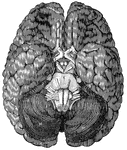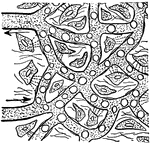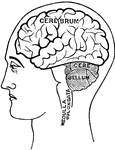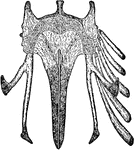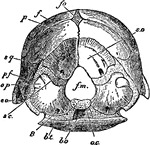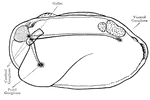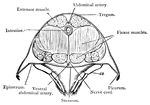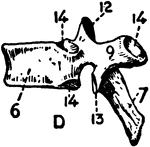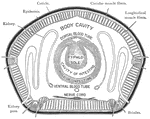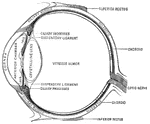
Blood vessels of the brain
"Arteries and their Branches at the Base of the Brain." — Blaisedell, 1904
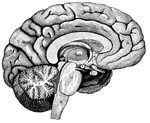
Left Half of the Brain
"A,frontal love of the cerebrum; B, parietal lobe; C, parieto-occipital lobe;…

Nerve Cells of the Brain
"Wherever nerve cells are abundant, the nerve tissue has a gray color; in other places, it looks white.…
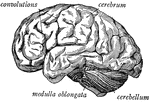
Side view of the brain
"The brain seen from the side, showing the three principal divisions." — Ritchie, 1918
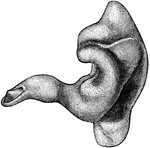
External auditory canal
"A Cast of the External Auditory Canal. The auditory canal is a passage in the solid potion of the temporal…

Longitudinal section of cartilage
"Showing (1) cartilage with martrix and cells; (2) cartilage with matrix containing cells and white…
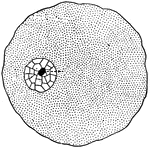
Cell
"In a general what we may describe a cell as a tiny mass of jelly in which floats another still smaller…

Various forms of cells
"A, columnar cells found lining various parts of the intestines (called columnar epthelium);…
Centipede
"A, a, Cephalic plate; b, Tergum of segment bearing first pair of legs (d); c, Tip of palpognath; e,…

Central Nervous System
"Brain and spinal cord, with the thirty-one pairs of spinal nerves." — Tracy, 1888
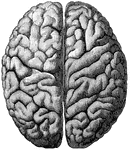
Cerebrum
"The Upper Surface of the Cerebrum. Showing its division into two hemispheres, and also of the convolutions."…

Intestinal Tract of Chauna Chavaria
cc. Colic caeca, d. Duodenum. g. Glandular patch, l.l. Meckel's tract, l.i. Hind-gut, p.v. Cut root…

Lateral section of the chest
"A, a muscle which aids in pushing the food down the esophagus; B, esophagus; C,…
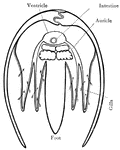
Clam
Cross section of the body of a clam, through the heart. Arrows indicate water current through the gills.
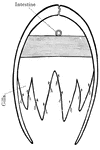
Clam
Cross section of the body of a clam, through the posterior adductor muscles. Arrows indicate water current…
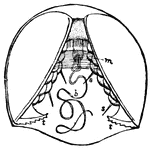
Clam
Young clam, still within the egg membrane. m, adductor muscle; t, hooks by which it attaches itself…
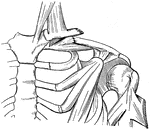
Broken Clavicle
"When a bone is broken, blood trickles out between the incjured parts, and afterwards gives place to…
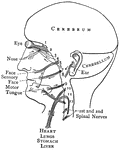
Distribution of the Cranial Nerves
"The cranial nerves are thus arranged in pairs: 1, olfactory nerves, special nerves of smell; 2, optic…
Crayfish
Longitudinal-section of a crayfish, showing digestive, circulatory, reproductive, excretory, and nervous…
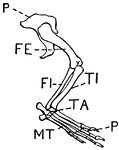
Leg of Crocodile
This illustration shows the leg of a crocodile. P. Pelvis, FE. Femur, TI. Tibia, FI. Fibula, TA. Tarsus,…

Heart of a Deer
"Cast or mold of the interior of the left ventricle of the heart of a deer. Shows that the left ventricular…
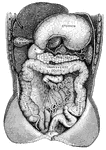
Digestive system
"Showing the Relations of the Stomach, Liver, Intestines, Spleen, and other Organs of the Abdomen. Aduodenum;…
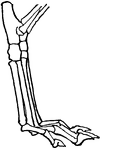
Leg of Dog
This illustration shows the leg of a dog. This leg is digitigrade. Animals with digitigrade legs walk…
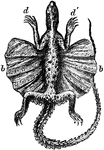
Red-Throated Dragon
"The Red-Throated Dragon shows a large membranous expansion (b b) situated between the anterior (d d)…
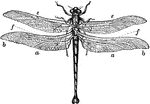
Dragonfly
An insect characterized by large multifaceted eyes, two pairs of strong transparent wings, and an elongated…

Bones of the Ear
"Across the middle ear a chain of three small bones stretches from the tympanic membrane to the inner…
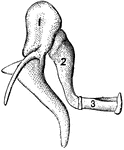
Bones of the Ear
"1, malleus, or hammer; 2, incus, or anvil; 3, stapes, or stirrup." — Blaisedell, 1904

Dyak's ear
"Many of both sexes wear enormous ear plugs and earrings, some of which are as big around as a napkin.…

Earthworm
Dorsal view of internal structures of earthworm after cutting through the dorsal wall lengthwise and…

African Elephant Skeleton
"Skeleton and Outline of African Elephant (Elephas or Loxodon africanus). fr, frontal; ma, mandible;…

Anterior Extremity of Elephant
"Shows how the bones of the arm (q), forearm (q'x), and foot (o), are twisted to form an osseous screw."—Pettigrew,…
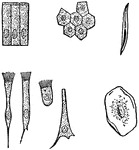
Various kinds of epithelial cells
"A, columnar cells of intestine; B, polyhedral cells of the conjuctiva; C, ciliated conical cells of…

Cross-Section of the Epithelium
"One of the simplest of the tissues in the body is called the epithelium, and its cells are…

Diagram of the Eye
"Diagram illustrating the Manner in which the Image of an Object is inverted on the Retina." — Blaisedell,…

Lens of the eye
"Diagram showing the Change in the Lens during Accomadation. On the right the lens is arranged for distant…
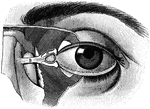
Eyeball
"The Relative Position of the Lachrymal Apparatus, the Eyeball, and the Eyelids. A, lachrymal canals,…
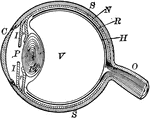
Eyeball
"The most essential parts of human vision are contained in the eyeball, a nearly spherical body, about…
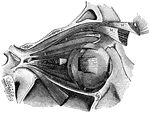
Muscles of the eyeball
"A, attachment of tendon connected with the four recti muscles; B, external rectus,…
